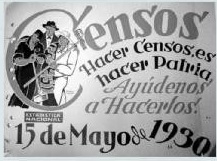By Robert Hill from the July 2010 Edition

Every 5 years the National Institute of Statistics and Geography (INEGI) conducts a census of the entire Republic, with the last one being taken in 2005.
One of the census takers came to my house the other day with a form to be completed for the 2010 census. I was fascinated by some of the questions she asked, compared to what may be expected in the U.S. or Canada.
Besides the standard demographic stuff about name, age, marital status, sex, etc., she wanted to know if I had electricity, gas, piped water, sewer, a telephone, TV, refrigerator, computer, cell phone, etc. in my home. She also wanted to know what my floors were made of (dirt, concrete, ceramic tile), what my religion is and my occupation. One question had to do with whether or not there was a separate room in the house for sleeping.
Later, as I thought about it, I realized that there are numerous families living in and around Manzanillo where Mom and Dad plus a whole bunch of kids live in a small, 3 room house, with a kitchen, bath and living room. At night the mats are rolled out and everyone sleeps on the floor next to each other. For such a family, having a separate bedroom is a big improvement in their lifestyle.
phones? All persons buying these phones will also have to have and give identification.
A nuisance for us but also for those engaged in criminal activities.
2005 CENSUS DATA
In 2005 the population of Manzanillo was about 138,000 and the largest of the 4 main Municipalities in the state of Colima. However, if you combine the population of Colima and Villa De Alvarez (which adjoin one another) you get a combined population of about 232,000 for that metropolitan area. I spoke with the manager of the Manzanillo Coca Cola distribution center not long ago, and he tells me that Manzanillo will show a dramatic increase in population this year, over 5 years ago when the last census was taken. He bases this on Coke sales which have risen sharply over the past 5 years. They have per capita consumption data going back many years, so with that they can forecast population rates based on their sales, with amazing accuracy. By the way, Mexico has the highest per capita consumption rate of Coca Cola in the entire world! (sorry to say.)
IN 2005…
Over 95% of the households in Colima had piped water, sewer, electricity and a TV. 89% had a refrigerator, but only 21% had a home computer (I guess this explains all the cyber cafes we see around Manzanillo).
The entire population of Colima over age 15 had an average education level of the 8th grade. (probably much higher in the urban areas).
88% of the state of Colima is considered urban, with 12% rural. This has shifted dramatically since 1930 when only 44% was urban, and 56% rural.
Six out of every 1,000 people in Colima over age 5 speak an indigenous language such as Nahuatl, Perespecha, or Zapotecas.
Colima has a relatively young population, with 55% under the age of 30.
The population of Colima represents only. 0.6% (less than 1%) of Mexico
IT WAS INTERESTING to note that no information was gathered in the census data which would indicate per capita
or household income levels. I can only guess at the reason for this omission, but income data is pretty basic for any demographer trying to describe a given population. We hear a lot about (and see evidence of) a rising middle class in Mexico, but without any income data it is pretty hard to make any reliable assumptions. Anyway, it will be most interesting to get the results of the 2010 census and see what has changed over the past 5 years.
Note: Everything in this article is based on printed data from INEGI (Instituto Nacional De Estadistica y Geografia)
Download the full edition or view it online




You must be logged in to post a comment.